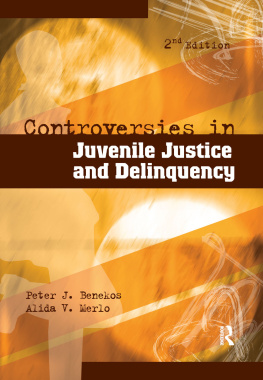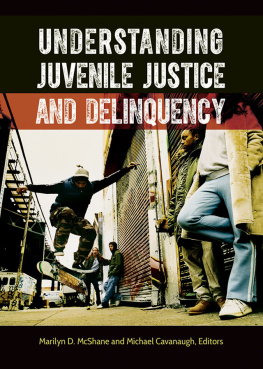First published in 1948
by Routledge, Trench, Trubner and Co., Ltd
Reprinted in 1998, 2002
by Routledge
2 Park Square, Milton Park, Abingdon, Oxon, OX14 4RN
Transferred to Digital Printing 2007
Routledge is an imprint of the Taylor & Francis Group
All rights reserved. No part of this book may be reprinted or reproduced or utilized in any form or by any electronic, mechanical, or other means, now known or hereafter invented, including photocopying and recording, or in any information storage or retrieval system, without permission in writing from the publishers.
The publishers have made every effort to contact authors/copyright holders of the works reprinted in The International Library of Sociology.
This has not been possible in every case, however, and we would welcome correspondence from those individuals/companies we have been unable to trace.
British Library Cataloguing in Publication Data
A CIP catalogue record for this book
is available from the British Library
Juvenile Delinquency in an English Middletown
ISBN 0-415-17742-1
The Sociology of Law and Criminology: 15 Volumes
ISBN 0-415-17832-0
The International Library of Sociology: 274 Volumes
ISBN 0-415-17838-X
Publisher's Note
The publisher has gone to great lengths to ensure the quality of this reprint but points out that some imperfections in the original may be apparent
THE local enquiry which forms the backbone of the present book may be regarded as a sequel to two other investigations: to the Home Office Enquiry into Juvenile Delinquency, undertaken at the London School of Economics, the results of which were published in 1942 under the title Young Offenders, by A. M. Carr-Saunders, H. Mannheim, and E. C. Rhodes, on the one hand, and to the Cambridge Evacuation Survey, published in 1941 under the editorship of Susan Isaacs with the co-operation of Sibyl Clement Brown and Robert H. Thouless, on the other. It was thought that the continued wartime residence of the School at Cambridge should be used as an opportunity for surveying the local position with regard to juvenile delinquency in a town of medium size, a category not included among the provincial cities from which material for Young Offenders had been drawn. After consultation with magistrates of the Cambridge Juvenile Court, it was arranged by the Director of the School, early in 1942, that the work should be undertaken jointly by Miss S. Clement Brown, M.A., then Tutor to the Mental Health Course of the School, and the present author. The magistrates very kindly consented to give access to their material and to further the enquiry in every way.
Unfortunately, from the point of view of this investigation, the Mental Health Course was soon afterwards able to return to London, which made it impossible henceforth for Miss Clement Brown to co-operate to the extent originally envisaged. She has, nevertheless, been kind enough to assist the author by frequently discussing with him the progress of the work, by collecting information concerning evacuee children who had returned to London, and by reading the manuscript of the original report and making many valuable suggestions. For all this, the sincere thanks of the author are due to her. It should be made clear, however, that she bears no responsibility whatsoever for the statements of fact or expressions of opinion contained in this book.
It would go too far to mention by name all those who have made this study possible by granting access to their material or by giving valuable information. Special acknowledgments are due in particular to the following authorities and officials or private bodies and their staffs:
The Juvenile Court Magistrates, and especially Mrs. C. D. Rackham, J.P., M.A., Borough Councillor and County Alderman. Mr. C. A. G. Harding, Clerk to the Justices.
The Borough Probation Officers, and especially Mr. M. J. Vine, Miss Norah E. Shearsmith, and Miss K. M. Ibbotson.
The former and the present Borough Chief Constables, and Superintendent W. Ainsworth.
The Borough Education Department, and especially Mr. T. F. Foreman, M.A., Education Officer, and the Headmasters and Headmistresses consulted.
The Borough Housing Department, and especially Dr. Alex. Wood.
The Cambridge Child Guidance Clinic, and especially Dr. H. Banister, Ph.D., Director, and Miss D. M. Hutchinson, M.A., psychiatric social worker.
The County Public Assistance Officer.
The County Youth Organizer and the Club Leaders consulted.
The Cambridge Associations for the Care of Girls.
The National Society for the Prevention of Cruelty to Children, and especially Superintendent-Inspector Mander.
Without their help, generously given, in spite of shortage of staff and many other wartime difficulties, the material required could not have been collected.
I am further indebted to the Magistrates and to the Cambridge Associations for the Care of Girls, for permission to publish information extracted from their respective records.
The Social Research Division of the London School of Economics, of which I am a member, had very early in the course of the enquiry expressed its approval of the scheme, and it has, throughout, interested itself in the progress of the work and given valuable advice and technical assistance, wherever required. For this, I wish to express my thanks to the Division and especially to its former Chairmen, Sir Alexander Carr-Saunders and Professor Morris Ginsberg, and to the present Chairman, Professor T. H. Marshall. It is hardly necessary to add that the Division is in no way responsible for the contents of this book.









